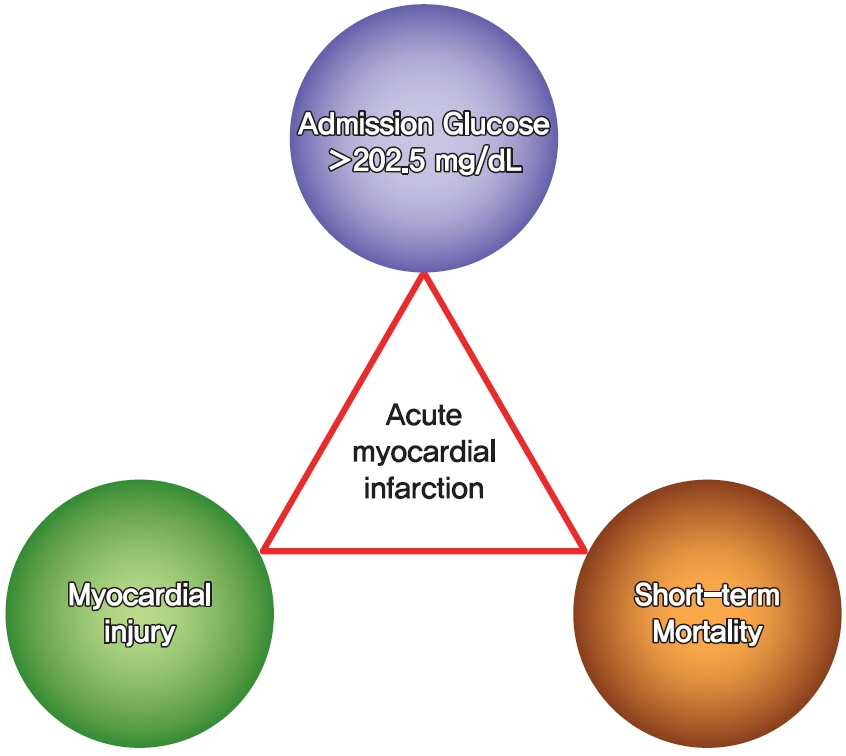Clinical Impact of Dysglycemia in Patients with an Acute Myocardial Infarction
- Affiliations
-
- 1Yeungnam University College of Medicine, Daegu, Korea.
- 2Division of Cardiology, Department of Internal Medicine, Yeungnam University Medical Center, Daegu, Korea.
- 3Division of Endocrinology, Department of Internal Medicine, Yeungnam University Medical Center, Daegu, Korea.
- KMID: 2514203
- DOI: http://doi.org/10.4093/dmj.2019.0164
Abstract
This study aimed to determine the impact of dysglycemia on myocardial injury and cardiac dysfunction in acute myocardial infarctions (AMIs). From 2005 to 2016, a total of 1,593 patients with AMIs who underwent percutaneous coronary intervention were enrolled. The patients were classified into five groups according to the admission glucose level: ≤80, 81 to 140, 141 to 200, 201 to 260, and ≥261 mg/dL. The clinical and echocardiographic parameters and 30-day mortality were analyzed. The peak troponin I and white blood cell levels had a positive linear relationship to the admission glucose level. The left ventricular ejection fraction had an inverted
U -shape trend, and the E/E' ratio wasU -shaped based on euglycemia. The 30-day mortality also increased as the admission glucose increased, and the cut-off value for predicting the mortality was 202.5 mg/dL. Dysglycemia, especially hyperglycemia, appears to be associated with myocardial injury and could be another adjunctive parameter for predicting mortality in patients with AMIs.
Figure
Cited by 3 articles
-
Clinical Impact of Dysglycemia in Patients with an Acute Myocardial Infarction (
Diabetes Metab J 2021;45:270-4)
Bo-Yeon Kim
Diabetes Metab J. 2021;45(5):787-788. doi: 10.4093/dmj.2021.0061.Clinical Impact of Dysglycemia in Patients with an Acute Myocardial Infarction (
Diabetes Metab J 2021;45:270-4)
Chan-Hee Lee
Diabetes Metab J. 2021;45(5):791-792. doi: 10.4093/dmj.2021.0190.The Effects of Glucose Lowering Agents on the Secondary Prevention of Coronary Artery Disease in Patients with Type 2 Diabetes
Inha Jung, Hyemi Kwon, Se Eun Park, Kyung-Do Han, Yong-Gyu Park, Eun-Jung Rhee, Won-Young Lee
Endocrinol Metab. 2021;36(5):977-987. doi: 10.3803/EnM.2021.1046.
Reference
-
1. Oswald GA, Corcoran S, Yudkin JS. Prevalence and risks of hyperglycaemia and undiagnosed diabetes in patients with acute myocardial infarction. Lancet. 1984; 1:1264–1267.
Article2. Pinto DS, Skolnick AH, Kirtane AJ, Murphy SA, Barron HV, Giugliano RP, et al. TIMI Study Group. U-shaped relationship of blood glucose with adverse outcomes among patients with ST-segment elevation myocardial infarction. J Am Coll Cardiol. 2005; 46:178–180.
Article3. Capes SE, Hunt D, Malmberg K, Gerstein HC. Stress hyperglycaemia and increased risk of death after myocardial infarction in patients with and without diabetes: a systematic overview. Lancet. 2000; 355:773–778.
Article4. Kosiborod M, Inzucchi SE, Goyal A, Krumholz HM, Masoudi FA, Xiao L, et al. Relationship between spontaneous and iatrogenic hypoglycemia and mortality in patients hospitalized with acute myocardial infarction. JAMA. 2009; 301:1556–1564.
Article5. American Diabetes Association. 2. Classification and diagnosis of diabetes. Diabetes Care. 2016; 39 Suppl 1:S13–S22.6. Lee SA, Cho SJ, Jeong MH, Kim YJ, Kim CJ, Cho MC, et al. KAMIR/KorMI Registry. Hypoglycemia at admission in patients with acute myocardial infarction predicts a higher 30-day mortality in patients with poorly controlled type 2 diabetes than in well-controlled patients. Diabetes Care. 2014; 37:2366–2373.
Article7. Kontos MC, Shah R, Fritz LM, Anderson FP, Tatum JL, Ornato JP, et al. Implication of different cardiac troponin I levels for clinical outcomes and prognosis of acute chest pain patients. J Am Coll Cardiol. 2004; 43:958–965.
Article8. Antman EM, Tanasijevic MJ, Thompson B, Schactman M, McCabe CH, Cannon CP, et al. Cardiac-specific troponin I levels to predict the risk of mortality in patients with acute coronary syndromes. N Engl J Med. 1996; 335:1342–1349.
Article9. Lofthus DM, Stevens SR, Armstrong PW, Granger CB, Mahaffey KW. Pattern of liver enzyme elevations in acute ST-elevation myocardial infarction. Coron Artery Dis. 2012; 23:22–30.
Article10. Sabatine MS, Morrow DA, Cannon CP, Murphy SA, Demopoulos LA, DiBattiste PM, et al. Relationship between baseline white blood cell count and degree of coronary artery disease and mortality in patients with acute coronary syndromes: a TACTICS-TIMI 18 (Treat Angina with Aggrastat and determine Cost of Therapy with an Invasive or Conservative Strategy: Thrombolysis in Myocardial Infarction 18 trial) substudy. J Am Coll Cardiol. 2002; 40:1761–1768.11. Thune JJ, Solomon SD. Left ventricular diastolic function following myocardial infarction. Curr Heart Fail Rep. 2006; 3:170–174.
Article12. Kettunen RV, Leppaluoto J, Jounela A, Vuolteenaho O. Plasma N-terminal atrial natriuretic peptide in acute myocardial infarction. Am Heart J. 1994; 127:1449–1455.
Article13. Ishihara M, Inoue I, Kawagoe T, Shimatani Y, Kurisu S, Nishioka K, et al. Impact of acute hyperglycemia on left ventricular function after reperfusion therapy in patients with a first anterior wall acute myocardial infarction. Am Heart J. 2003; 146:674–678.
Article14. Ishihara M, Kojima S, Sakamoto T, Kimura K, Kosuge M, Asada Y, et al. Japanese Acute Coronary Syndrome Study (JACSS) Investigators. Comparison of blood glucose values on admission for acute myocardial infarction in patients with versus without diabetes mellitus. Am J Cardiol. 2009; 104:769–774.
Article
- Full Text Links
- Actions
-
Cited
- CITED
-
- Close
- Share
- Similar articles
-
- Clinical Impact of Dysglycemia in Patients with an Acute Myocardial Infarction (Diabetes Metab J 2021;45:270-4)
- Clinical Impact of Dysglycemia in Patients with an Acute Myocardial Infarction (Diabetes Metab J 2021;45:270-4)
- Invasive Treatment of Acute Myocardial Infarction: What is the Optimal Therapy for Acute Myocardial Infarction?
- Primary Coronary Stenting as a Successful Treatment of Acute Myocardial
- Can time delay be shortened in the treatment of acute myocardial infarction?: Experience from Korea acute myocardial infarction registry


